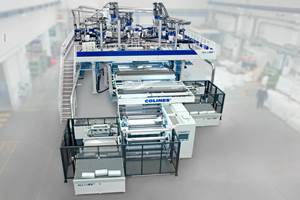First Expandable TPU is Key to Revolutionizing the Bicycle Saddle
BASF’s E-TPU and Ergon’s design and engineering knowhow have led to the ST Core Ultra bike saddle.
It was just four years ago that BASF launched what is believed to be the first expandable TPU (E-TPU). Known as Infinergy, the material is based on BASF’s Elastollan TPU which is expanded via use of an innovative procedure. Infinergy closed-cell particle foam boasts a low bulk weight, with a density of 110 kilograms per cubic meter. After processing on standard molding machines, it has a molded part weight of 200 to 320 kg/m3, which positions it between the generally lighter EPS or EPP and the heavier elastomeric PUR foams. It also boasts less than 2% by volume in 24 hrs of water absorption along with a very high breaking elongation of between 100-150% depending on density, and a combinations of good abrasion- and chemical-resistance.
Fast forward, and Infinergy E-TPU—through a collaborative effort between BASF and Germany’s Ergon, a design and engineering firm with the aim to develop products that offer “perfect ergonomics” for cyclists—is playing the major role in revolutionizing the bicycle saddle.
In fact, the partners note that there has been no significant changes to bicycle saddle technology since the 1960s, with most models conforming to a standardized principle: rails, saddle shell, padding, cover. This construction’s disadvantage is that the seat shell—being the substructure for the padding—results in a stiff seat shell, which restricts seating comfort.
By focusing on this aspect in particular, Ergon’s R&D team was led, in their view, to the development of the revolutionary ‘TwinShell technology’, with an ergonomic core. Two shells function in isolation from each other in a sandwich construction, held in a floating arrangement by a high-performance elastomer damper made of BASF’s Infinergy. The lower, supporting shell performs a load-bearing function while the upper, flexible seat shell supports the padding.
This design principle both increases comfort and also allows for an entirely new form of pedaling ergonomics. As a result of isolating the seat shell from the supporting shell, the saddle follows the natural pedaling movements in all directions. This has the advantages of: systematically combining optimized pressure distribution across the site bones, efficient pedaling ergonomics, excellent vibration damping and active back protection.
Meanwhile, the Ergon core is made of Infinergy as well. This innovative material is setting new standards in relation to damping and suspension due to thousands of light and highly elastic foam particles. The high elasticity reportedly optimizes the damping of pressure in the seat area. As soon as the pressure impulse has passed, the foam springs back into its old shape. The material retains this property even under continuous load. The Ergon core thus is said to ensure a direct damping response and the highest possible resilience, as well as maximum durability at minimal material weight. This E-TPU foam has already been used successfully by leading manufacturers in the safety and running shoe sectors.
Commenting on the new ST Core Ultra—to be made commercially available in the U.S. and Europe starting February 2018, Ergon founder and CEO Frank Arnold noted:
“The idea of a design principle using TwinShell technology and an ergonomic core has been around for a while, but we were never able to find a suitable material on the market to implement this project. Now, Infinergy from BASF has exceeded our expectations. I am absolutely certain that Ergon will cause a stir in the bicycle industry with its ST Core Ultra.”
Related Content
Foam-Core Multilayer Blow Molding: How It’s Done
Learn here how to take advantage of new lightweighting and recycle utilization opportunities in consumer packaging, thanks to a collaboration of leaders in microcellular foaming and multilayer head design.
Read MoreABC Technologies to Acquire Windsor Mold Group Technologies
The Tier One automotive supplier with compounding and blowmolding machine capabilities adds the 50-yr-old molder and moldmaker.
Read MoreYoung Stretch-Film Processor Bets on Nanolayers
Going up against companies with as much as double its capacity, young stretch-film processor Zummit believes that new technology — notably 59-nanolayer films — will give it a competitive edge.
Read MoreBest Methods of Molding Undercuts
Producing plastics parts with undercuts presents distinct challenges for molders.
Read MoreRead Next
Troubleshooting Screw and Barrel Wear in Extrusion
Extruder screws and barrels will wear over time. If you are seeing a reduction in specific rate and higher discharge temperatures, wear is the likely culprit.
Read MoreWhy (and What) You Need to Dry
Other than polyolefins, almost every other polymer exhibits some level of polarity and therefore can absorb a certain amount of moisture from the atmosphere. Here’s a look at some of these materials, and what needs to be done to dry them.
Read MoreLead the Conversation, Change the Conversation
Coverage of single-use plastics can be both misleading and demoralizing. Here are 10 tips for changing the perception of the plastics industry at your company and in your community.
Read More







.png;maxWidth=300;quality=90)


















